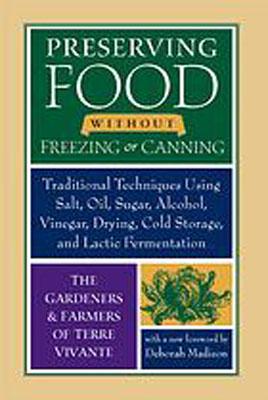 |
| Preserving Food, 2007 edition |
By Roberta Bailey
Keeping Food Fresh: Old World Techniques and Recipes
The Gardeners and Farmers of Terre Vivante
Chelsea Green Publishing Company, 1999. (1-800-639-4099) 198 pp., $16.95.
The Centre Terre Vivante is an ecological research and educational center in Mens, Domaine de Raud, a region in Southern France. The center hosts courses on regenerative gardening and farming, renewable energy, and ecological building techniques, as well as publishing over fifty books and its influential gardening magazine, Les Quatre Saisons du Jardinage.
When Les Quatre Saisons du Jardinage asked its readers to share their recipes for fruit and vegetable preservation, over 500 recipes arrived, some classics, some new and adapted, some never before printed because they were considered common knowledge. From this outpouring came Keeping Food Fresh, a compilation of traditional, new, and adapted French techniques for preserving and storing fresh food. Canning and freezing techniques were deliberately left out because these storage methods tend to remove the life from food. The 250 recipes chosen use techniques that maximize flavor and nutrition with minimal boiling or cold or use of sugar. They tend to be less costly, and more energy efficient. In the way that heirloom vegetables have been sought for their flavor and history, these preservation methods bring back history and teach us new ways to appreciate the life-giving flavor in plants.
Sections include a foreword by Eliot Coleman, preserving in the ground or root cellar, preserving by drying and by lactic fermentation, preserving in oil, in vinegar, with salt, with sugar, with alcohol, and sweet and sour preserves, as well as food safety guidelines and tips for choosing the best method for your crops.
Recipes include cabbage sauce, bottled Swiss chard, lacto-fermented sweet corn, sauerkraut with whole cabbages, layered apple paste, and sugar-free jams. Although techniques are time tested, you won’t find some of them in publications put out by our extension agents. Some, such as preserving in oil, would be considered too risky, so use this book with care.
Preserving in the Ground and Cellar
Endive in Buckets
Endive roots
buckets, topsoil, and black plastic
We pull out endive roots and allow them to dry on the ground for a few hours, then remove the leaves just above the crown. We place our roots in a bucket along with some topsoil, and store them in the cellar. When we need some endive, we bring up a bucket and store it in the kitchen closet or cover it with black plastic. We water it once or twice, new succulent leaves grow from the roots, and that’s how we have endive for part of the winter. – Jean-Yves Cousseau, Millau
Preserving by Drying
Vegetable Bouillon Powder
Celeriac, celery leaves, carrot, garlic, leeks, onions
Brewer’s yeast
tomatoes (optional)
parsley, basil, and other herbs (optional)
drying apparatus
blender
small glass jars
Dry the celeriac, celery leaves, carrots, garlic, leeks, and some onion. Once dry, place these vegetables in a blender, reduce to a powder, and combine with brewer’s yeast.
The powder will keep one to two years stored in small jars in a dry place.
You can vary the ingredients, for example, to make a bouillon cube with dried sliced tomatoes (put through the blender) as a predominant flavor. You can also dry parsley, basil, celery leaves, and other aromatic herbs, which will keep their color and flavor for one year if stored in airtight jars. Reduce them to a powder and blend them into mixes as I’ve explained, or better yet, keep them in separate small jars to have them on hand for specific flavorings and uses. – Eva Wiehl, Buis-les-Baronnies
Recipes reprinted with permission of Chelsea Green Publishing Company.
